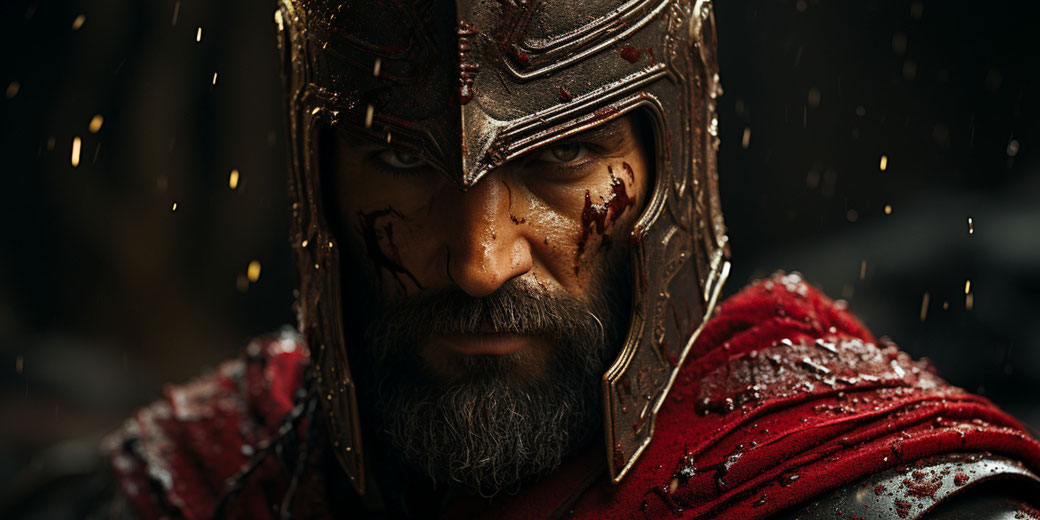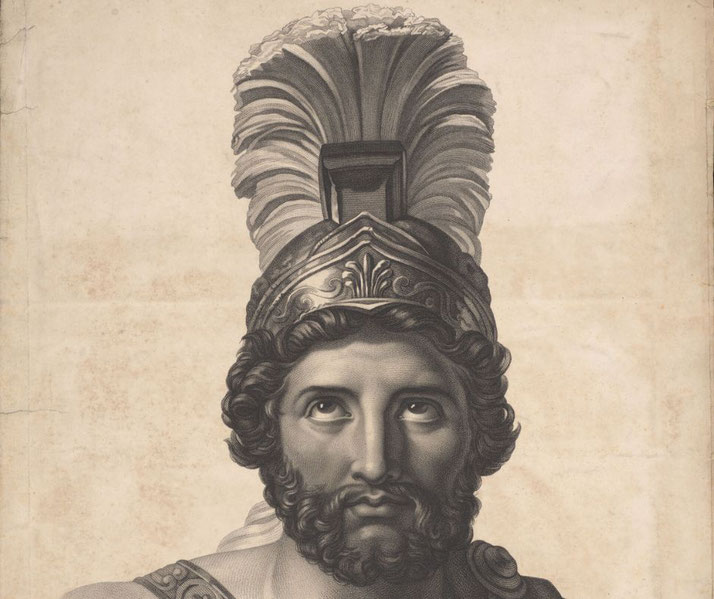Who was Leonidas, the legendary Spartan king who died at Thermopylae?

Born into a world where the might of a warrior was the cornerstone of respect and power, Leonidas epitomized the Spartan ideals of courage, discipline, and leadership.
As a product of Sparta's rigorous military training, he emerged not only as a formidable warrior but also as a leader whose decisions and actions would significantly influence the course of Greek history.
But how much truth is there behind the celebrated myth?
The story of Leonidas' childhood
Leonidas was born around 540 BCE into the royal Agiad dynasty of Sparta, a lineage that traced its roots to the mythical hero Heracles.
His father, King Anaxandridas II, was a respected ruler in a society where lineage and military prowess were paramount.
Leonidas, as a Spartan prince, was not destined to ascend the throne initially, as he had an older half-brother, Cleomenes I, who was the heir apparent.
This early period of his life, like that of all Spartan boys, was shaped by the rigorous and austere upbringing typical of Sparta, known as the Agoge.
The Agoge was a state-sponsored education and training program focused on cultivating military, survival, and social skills.
Beginning at the age of seven, Leonidas, like his peers, would have been removed from his family and placed in this communal system.
Here, he underwent intense physical training, learned combat tactics, and was imbued with values of discipline, endurance, and loyalty to Sparta.
The Agoge was not only a military training ground but also a means of instilling the ethos of Spartan society, creating citizens who were resilient, obedient, and ready to sacrifice for the greater good of their city-state.
During these formative years, Leonidas would have also been exposed to the harsh realities and expectations of Spartan life.
The society was strictly organized and highly militaristic, with an emphasis on conformity and excellence in physical prowess.
Spartan education aimed to produce warriors capable of withstanding the rigors of battle and upholding the city-state's reputation as a military powerhouse.

Leonidas as a Spartan king
Leonidas' ascension to kingship, in circa 490 BCE, was a result of unforeseen familial circumstances.
Initially, Leonidas was not in direct line for the throne, being the third son of King Anaxandridas II.
His older half-brother Cleomenes I, born to a different mother, was the reigning king.
However, the untimely and somewhat mysterious death of Cleomenes in 490 BCE, coupled with questions surrounding the legitimacy of his daughter Gorgo, altered the course of succession.
In Sparta, the system of governance was unique, featuring two royal families – the Agiads and the Eurypontids – each providing a king who ruled simultaneously.
This dual kingship system was designed to balance power and prevent tyranny.
Leonidas, belonging to the Agiad dynasty, found himself next in line after the death of Cleomenes, as his older full brother, Dorieus, had previously died in a military campaign.
Sparta's role in the Greco-Persian Wars
As king, Leonidas inherited a state that was a key player in the ongoing power struggles between Greek city-states and the expanding Persian Empire.
Leonidas' rule thus began at a time of growing tensions and impending conflict, setting the stage for his pivotal role in the Greco-Persian Wars.
These wars, spanning from 499 BCE to 449 BCE, were rooted in the Persian Empire's ambitions to expand westward into the Greek mainland, following their successful subjugation of the Greek cities in Asia Minor.
The first major encounter, the Battle of Marathon in 490 BCE, marked a surprising victory for the Athenians, bolstering Greek confidence and setting the stage for further confrontations.
Leonidas' most significant involvement in the Persian Wars came during the second Persian invasion, led by King Xerxes I in 480 BCE.
This massive campaign was a direct response to the defeat at Marathon and aimed to decisively subjugate Greece.
The Greeks, aware of the impending threat, formed an alliance of city-states, known as the Hellenic League, spearheaded by Sparta and Athens.
Leonidas at the Battle of Thermopylae
The Battle of Thermopylae, fought in August 480 BCE, was a key moment in the second Persian invasion of Greece, led by King Xerxes I, and is particularly remembered for the heroic stand of King Leonidas I of Sparta and his 300 elite Spartans.
The Persian force, vast in number and confident after their earlier successes, aimed to continue their westward expansion.
In response, the Greek city-states, under the banner of the Hellenic League, decided to block the advance of the Persian army at the narrow coastal pass of Thermopylae, a natural choke point.
Leonidas, chosen to lead the Greek forces due to his military expertise, spearheaded the defense with a small force.
Estimates suggest the Greeks initially numbered around 7,000, a figure that pales in comparison to the tens of thousands, if not hundreds of thousands, in the Persian army.
The narrow pass at Thermopylae neutralized the numerical advantage of the Persians, allowing the Greeks to use their superior heavy infantry tactics effectively.
The Spartan hoplites, at the heart of this defense, were crucial, as their training, discipline, and equipment were ideal for such close-quarters combat.
For two days, the Greek forces successfully held their ground, repelling the Persian assaults.
The Spartans, well-equipped and experienced, were instrumental in these defensive efforts, showcasing their military prowess.
The situation, however, took a drastic turn when a Greek traitor named Ephialtes informed Xerxes of a hidden mountain path that led behind the Greek lines.
This revelation allowed the Persians to outflank the Greek position, turning the tide of the battle.

The legendary account of Leonidas' death
Faced with the inevitability of defeat, Leonidas made a fateful decision. He dismissed the bulk of the Greek army, choosing to stay behind with his 300 Spartans, along with 700 Thespians and 400 Thebans who refused to leave.
This final stand was not a strategic move to win the battle but a sacrificial effort to delay the Persians and protect the retreating Greek forces.
On the third day of the battle, the Persians, having encircled the remaining Greeks, launched a full assault.
Leonidas and his men fought valiantly, but they were ultimately overwhelmed and slain.
Leonidas himself was among the last to die, fighting valiantly until he was cut down by Xerxes' guards.
The Battle of Thermopylae, despite being a military defeat, had significant strategic implications.
It delayed the Persian advance and provided valuable time for the Greek city-states to prepare for further battles.
The sacrifice of Leonidas and his Spartans became a rallying point for the Greek city-states, symbolizing the depth of their commitment to defending their homeland.
The war continued with several more crucial battles, including the naval Battle of Salamis later in 480 BCE and the Battle of Plataea in 479 BCE, where the Greeks eventually secured victory, ensuring the survival and autonomy of the Greek city-states.
The problematic nature of the historical account
The story of Leonidas and the Battle of Thermopylae, while revered, is not without its controversies and debates.
One major point of discussion among historians revolves around the accuracy of the historical accounts.
Much of what is known about Leonidas and Thermopylae comes from Herodotus, who wrote his account several decades after the events.
As a result, some scholars question the reliability of these narratives, suggesting that they may have been embellished or influenced by the passage of time and the oral tradition of storytelling prevalent in ancient Greece.
The strategic importance of the Battle of Thermopylae itself has also been a subject of debate.
While the battle is often glorified as a crucial stand against overwhelming odds, some historians argue that it was a tactical misstep.
They suggest that the Greek forces could have been more effectively used in other defensive positions or in a more coordinated retreat, rather than being sacrificed in a doomed stand.
This perspective views the decision of Leonidas and his men to fight to the death as more of a symbolic gesture than a sound military strategy.
What do you need help with?
Download ready-to-use digital learning resources
Copyright © History Skills 2014-2024.
Contact via email
With the exception of links to external sites, some historical sources and extracts from specific publications, all content on this website is copyrighted by History Skills. This content may not be copied, republished or redistributed without written permission from the website creator. Please use the Contact page to obtain relevant permission.





